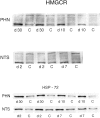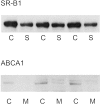Experimental glomerulopathy alters renal cortical cholesterol, SR-B1, ABCA1, and HMG CoA reductase expression
- PMID: 12507911
- PMCID: PMC1851117
- DOI: 10.1016/S0002-9440(10)63819-9
Experimental glomerulopathy alters renal cortical cholesterol, SR-B1, ABCA1, and HMG CoA reductase expression
Abstract
Previous studies indicate that acute tubular injury causes free cholesterol (FC) and cholesteryl ester (CE) accumulation within renal cortex/proximal tubules. This study assessed whether similar changes occur with glomerulopathy/nephrotic syndrome, in which high-circulating/filtered lipoprotein levels increase renal cholesterol supply. Potential adaptive changes in cholesterol synthetic/transport proteins were also assessed. Nephrotoxic serum (NTS) or passive Heymann nephritis (PHN) was induced in Sprague-Dawley rats. Renal injury (blood urea nitrogen, proteinuria) was assessed 2 and 7 days (NTS), or 10 and 30 days (PHN) later. FC and CE levels in renal cortex, isolated glomeruli, and proximal tubule segments were determined. SR-B1 (a CE influx protein), ABCA1 (a FC exporter), and HMG CoA reductase protein/mRNA levels were also assessed. FC was minimally elevated in renal cortex (0 to 15%), the majority apparently localizing to proximal tubules. More dramatic CE elevations were found ( approximately 5 to 15x), correlating with the severity of proteinuria at any single time point (r >/= 0.85). Cholesterol increments were associated with decreased SR-B1, increased ABCA1, and increased HMG CoA reductase (HMGCR) protein and its mRNA. Tubule (HK-2) cell culture data indicated that SR-B1 and ABCA1 levels are responsive to cholesterol supply. Experimental nephropathy can increase renal FC, and particularly CE, levels, most notably in proximal tubules. These changes are associated with adaptations in SR-B1 and ABCA1 expression, which are physiologically appropriate changes for a cholesterol overload state. However, HMGCR protein/mRNA increments can also result. These seem to reflect a maladaptive response, potentially contributing to a cell cholesterol overload state.
Figures










References
-
- Zager RA, Burkhart KM, Johnson A, Sacks B: Increased proximal tubular cholesterol content: implications for cell injury and the emergence of “acquired cytoresistance.” Kidney Int 1999, 56:1788-1797 - PubMed
-
- Zager RA, Johnson A, Anderson K, Wright S: Cholesterol ester accumulation: an immediate consequence of acute ischemic renal injury. Kidney Int 2001, 59:1750-1761 - PubMed
-
- Zager RA, Johnson AC: Renal cortical cholesterol accumulation: an integral component of the systemic stress response. Kidney Int 2001, 60:2229-2310 - PubMed
Publication types
MeSH terms
Substances
Grants and funding
LinkOut - more resources
Full Text Sources
Medical
Research Materials

